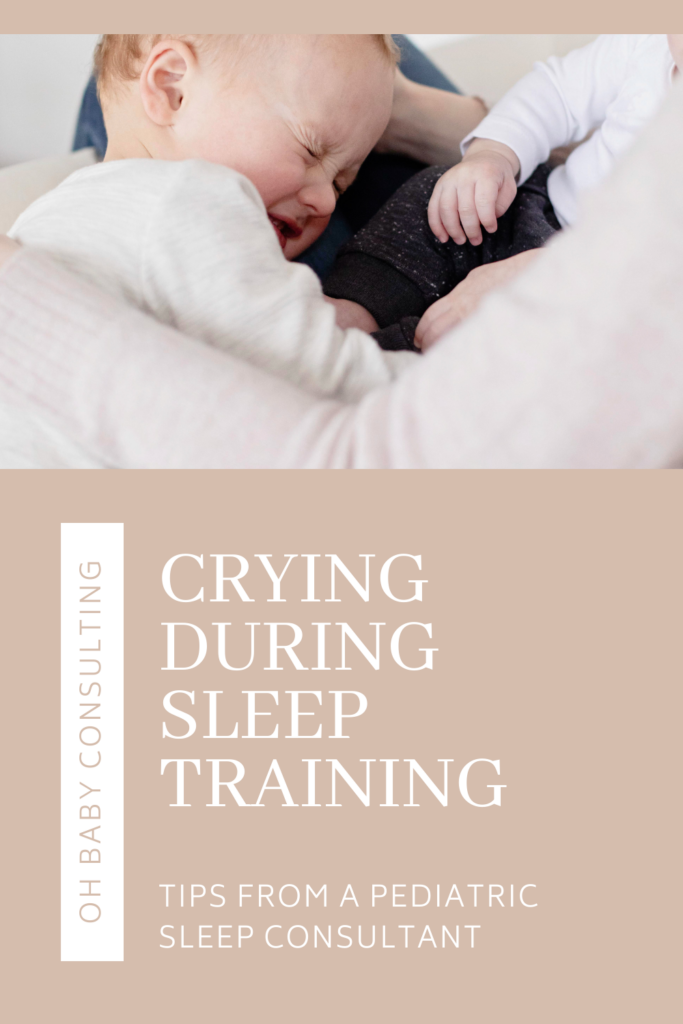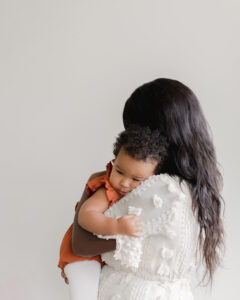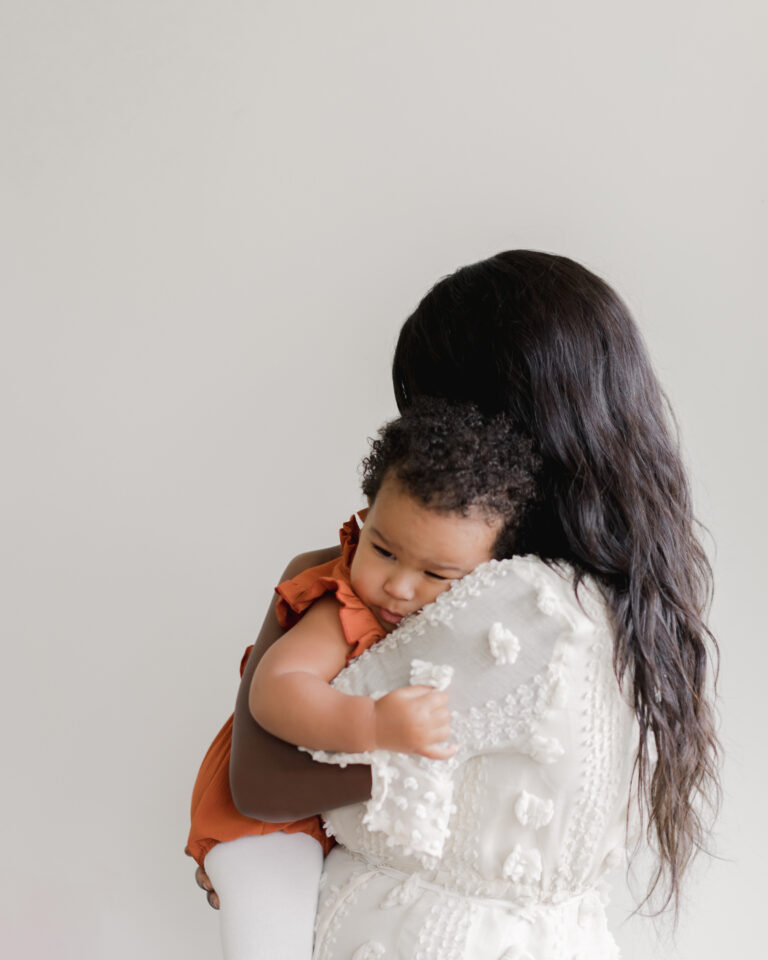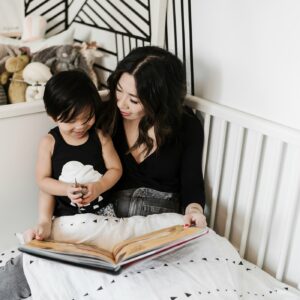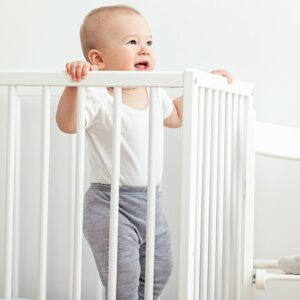The number one question I get from parents at the beginning of our sleep teaching journey is, “How much will my baby cry?” I wish I could give you a concrete answer, but unfortunately the amount of crying is hard to predict. Every baby is so unique, and the intensity and duration of change-related protests is dependent on so many factors such as your baby’s temperament, how much sleep debt they’re carrying, and how comprehensive & consistent you are in your approach (aka, do you have a PLAN!?)
I want you to know that the visceral response you have to hearing your baby cry is incredibly normal. The sound of our own babies crying actually triggers parts of our brain associated with attention and empathy (which is super helpful for babies in grabbing the attention of their caregivers to get their needs met.) Unfortunately, there is also scary misinformation out there that leaves parents with the impression that any type of crying can cause neurological damage or will hinder the attachment relationship.
My goal is to help clear up some of the misleading information and understand the research about crying so that you can make a more informed decision about whether or not sleep training is right for your family and reconcile any uncomfortable feelings that tears in general may cause you.
The history of crying concerns
Concerns about crying causing harm was not always such a contentious issue. When I was a baby in the 1980s – and in fact up until the early 1990s – letting a baby cry for a reasonable amount of time while you were cooking dinner, at bedtime, or during night wake-ups was a common parenting practice. While unpleasant, there were no concerns that this was unsafe. In 1993, Dr. William Sears introduced the concept of Attachment Parenting which warned against sleep training citing that prolonged crying caused brain damage and trust issues.
This claim is certainly frightening when taken at face value, especially because it appears like Dr. Sears has evidence to support his theories. However, a deeper dive into the research shows that the information they are basing their theories is misused and false.
The data from the studies used to support Dr. Sears’ claims comes from a small sample of babies who were exposed to chronic abuse & neglect and raised in orphanages without strong attachment figures (very much unlike the household in which you are raising your baby.) In fact, the Yale researchers who conducted one of the studies actually cited that Sears’ use of their work was misleading and that their paper was “not referring to routine, brief stressful experiences but to abuse and neglect.” He went on to say that it was a “mis-citation of our work to support a non-scientifically justified idea.”
To be clear, I strongly support many attachment parenting practices including breastfeeding, babywearing, and being attuned to your baby, I just respectfully disagree with Dr. Sears’ stance on sleep training, especially since it is not backed by very strong data and discourages parents from addressing sleep issues that may be negatively impacting the mental, physical, and emotional well-being of their entire family (which can be damaging!)
There is a plethora of research supporting the safety of sleep training and longitudinal data to negate any adverse impacts. But even though there are studies to support the safety and efficacy of sleep training, it doesn’t diminish the fact that the crying that comes along with it can be hard to tolerate.
Why is my baby crying?
Let’s start by uncovering why the crying is happening in the first place. People tend to be very protective of their sleep environments; we all like things to be the same every night and we get used to it. In fact, the way a baby learns how to fall asleep at naps bedtime and fall back to sleep in the middle of the night is all they know. That means, making a big change to their entire sleep worldview is bound to be met with some protest. And crying is just that: protest.
Crying is a normal part of the human experience and is your baby’s way of communicating. Just like your newborn may have protested tummy time when it was brand new, so too will they be vocal about the newness of their sleep situation. Crying is not a bad thing, contrary to the feelings it may elicit inside of us. But stepping outside of our own adult perceptions about what tears mean can be revolutionary in really attuning to your child vs. shutting down very real emotions and never allowing for uncomfortable/mad/sad feelings (which can then cyclically result in your baby growing into an adult who is triggered by crying, and so on.)
Reframing the tears
If you are very triggered by crying, it can be helpful to reframe the way you look at it, because your baby is going to cry – a lot – during their childhood (and beyond) even when we are trying to do right by them. Think about what you assume to be true when your child cries. Do you think to yourself:
- I’m a bad parent
- I cannot meet my child’s needs
- My baby is not normal because they are crying
- My baby’s emotions are too big and it is my job to make them stop otherwise I am doing something wrong
- There is always a reason that my baby is crying and I must be missing something if there are tears
In reality, crying is much more complex. Not all crying is an indication of an immediate need or want. In fact, just like adults, crying is also a natural stress-release mechanism and wind-down tactic. Crying is a way to express big emotions, and those big emotions don’t need to be stopped or tiptoed around. It’s OKAY for your little one to have big feelings about things like change, a new routine, or something they just don’t like.
Crying around sleep is really no different from crying at other points in time during the day. Think about strapping your baby into a car seat. Your baby might scream as you put them in and continue to be upset the entire time you’re driving until you reach you destination. But that doesn’t mean you get them out of the car seat and let them crawl around the car while it’s moving (you may not even pull over to console them.) Instead, you prioritize their safety even if it means they’re unhappy with it. Their dislike of the car seat doesn’t stop you from using it.
So, during sleep teaching, instead of thinking that your little one is crying because they’re lonely, sad, or feeling abandoned think about the actual reason they’re probably crying:
- They’re tired (but not quite sure what to do about it)
- They’re in a new & different situation
- They’re releasing built up tension and energy from the day
- They’re exercising their sleep muscles (hard work!)
- They prefer the “old way” of doing things
- They’re frustrated as they navigate the learning process
Also, consider how much crying is happening right now, in your current situation. Think about if you do nothing, how much cumulative crying that would amount to over time. Now think about actually solving the root of the problem; teaching your baby how to initiate sleep on their own easily & peacefully in order to get a night-full of restorative sleep. While there may be an uptick in crying initially, over the long-term there will likely be much less crying overall.
You’re not a bad parent if your child cries
I understand that crying (especially from babies) can be super triggering to so many people for so many reasons, but oftentimes our discomfort with crying prevents us from holding space for our child while they experience the big emotions that accompany the different events within and stages of their life. Oftentimes parents view themselves (and think others will view them as) failures if their child cries. They mistakenly believe that if they were doing a better job, their child wouldn’t cry.
This is completely unrealistic.
Your child is going to cry, in fact, it’s in the job description of being a human! As a parent, you can support your child by regulating your own (oftentimes visceral) feelings that crying brings up and supporting your child through their big emotions vs. crusading to stop them at all costs and leaving them with unresolved feelings. Because one of the greatest skills YOU can master is tuning in to WHY the tears are happening vs. going on a quest to solve them immediately.
So I’ll leave you with the reminder that it’s OKAY for your children to HAVE and EXPRESS big feelings. Even though it is so tempting to want to immediately intervene & fix things to make the tears stop, holding space for your little one to experience their feelings in a loving and supportive environment is not only going to move the needle forward in improving everyone’s sleep situation, but will also provide your babe with lifelong skills that they will use again and again as they grow.
And if you want a hand to hold during the sleep teaching process, I’m here to support you during the newness & change just as you will be supporting your baby.
A few notes:
Some crying during sleep training is normal and expected, but having a PLAN will ensure you’re sleep training in a fair way for your baby. This will help you see quicker and longer-lasting success and, arguably more importantly, help you feel empowered and stay committed to the process.
Sleep training during the newborn stage is not age-appropriate. For more information on when you can consider sleep training, check out this blog post and speak with your pediatrician.
